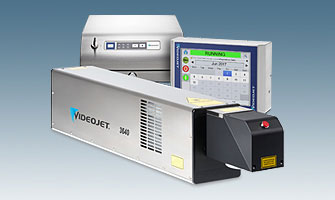Laser Marking Machines for permanent printing on glass
Another solution for printing on glass, laser marking produces permanent high-resolution codes on nearly any color or type of glass. The permanent marks protect codes from being tampered with by unauthorized channels. Moreover, the high quality marks enable clear coding and help instill brand confidence with customers.
Laser marking systems like the Videojet 3640 CO2 laser and Videojet 7810 UV laser produce micro cracks that etch into the glass surface to produce serial numbers, internal tracking numbers, and traceability information on clear and colored glass.
When a laser places a code or mark on a plastic surface, it does so by using high heat to melt the plastic material, ablating (removing) part of it and leaving a mark in the surface. By thus altering the surface, the laser leaves a mark more permanent than a printed one that can be altered by being placed on a wet bottle surface, washed away during processing or damaged by abrasion during handling.
When a laser hits glass, however, the result is completely different: the glass fractures. Natural grains and crystalline structures in the surface, when heated very quickly, will separate a microscopic sized “chip” from the surface as the hot piece expands rapidly relative to its surroundings. In this way, lasers are used to etch or engrave on glass, and if the power, speed and focus are all well controlled, excellent results can be achieved.
Using this process, glass bottles, vials and jars can be marked with lasers to produce serial numbers, internal tracking codes, and alphanumeric traceability information on both clear and colored glass. This is especially important in those processing venues where is a great deal of moisture is present that can dissolve inks or loosen labels, or where product handling can abrade or smear printed codes. The permanent laser etched marks protect codes from being tampered with by unauthorized channels, and the high quality marks that result enable clear coding that helps instill brand confidence among customers.
The glass ablation produced by the laser process produces visual consistency for alphanumeric codes, but cannot be relied on for consistency over the larger areas required for more complex figures such as 2D codes. It is also essential that a system be in place to remove glass chips as they are flaked off, to ensure they do not interfere with the laser beam as it creates subsequent characters.
A good example of how laser glass etching technology has been adopted into an industry norm is the production line. In this particular setup, the laser beam is directed towards a rotating or vibrating mirror. The mirror moves in a manner that traces out numbers and letters onto the surface being marked. This is particularly useful for printing dates, expiry codes, and lot numbering of products travelling along a production line in (for example) a pharmaceutical, food or beverage bottling line. Laser etching allows the glass bottles to be marked “on the move.” The location where the marking takes place is called a “marking laser station,” an entity often found in packaging and bottling plants. The speed of laser etching systems has largely led to them replacing older, slower technologies such as the hot stamping and pad printing of marks on glass as production line speeds have increased.
Talk to Videojet specialist about your application. +254-20-3893800
- Suggested Solutions
- Documents
Contact Us
New Equipment Sales:
+254-701-373789


